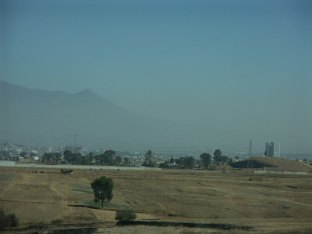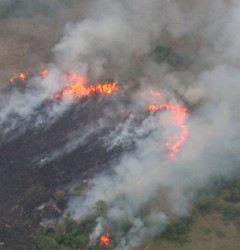|
|
 |
|
|
|
 |
 |
|
|
 |
Fundamentals A: Perception of air
You can feel air when it moves and wind wafts over your skin. But even when there is no wind, you can recognize the air rather well. If you go by bike or you open a door quickly, you feel the resistance of the air. Air is something not easy to describe, but it is there.
|
Can we also see the air? The gases of the air are invisible to our eyes. Nevertheless, the eye sees something in the air. It can be a certain dimming coming from the humidity of the air. It can also be a yellowish or brownish colour, which is caused by dust or exhaust gases.
We could ask: Does this, what we see there, also belong to the air?
|
 |
 |
 |
|
1. Puebla / Mexico: In particular on the right hand side of the image, over the centre of the town, the air is dimmed from exhaust gases.
Photo: Elmar Uherek
|
|
|
|
 |
2. Fog in the streets of Seattle. Condensed water makes the air opaque. Photo: Tom Harpel (Wikipedia GNU licence) |
|
 What do we find in the air? What do we find in the air?
Air does not only consist out of gases, it also carries other matter. For sure you have already been blowing soap bubbles. With the help of a ring to blow through, they are easily produced as if by magic from water and detergent.
|
For a while they float in the air and the air carries the bubbles of water and detergent. After a while they burst. Is the water still in the air after bursting? Hardly, it may fall as a little drop to the ground. Or the bubbles fly against the leaf of a tree or a wall, burst there and the water sticks to this barrier.
3. Soap bubbles; Photo: Walter J.Pilsak, Wikipedia GNU Licence
|
 |
|
|
|
 |
Nature sends a lot of things by "air mail", too. Maybe you know the dandelions. Children like to blow at the little seeds and make them fly away with the wind. This is how the plants propagate.
4. Photo on the left: Dandelion seeds (GNU Wikipedia)
|
The inhabitants of desert regions often observe that the air is full of fine dust and sand. The wind takes the matter up from the ground and it is often transported over several hundred kilometres. Dust and sand from the Sahara can even reach Europe on some days.
5. On the right: One of the largest sandstorms ever observed by a satellite (28.2.2000) carries a dust cloud larger than Spain far across the Atlantic Ocean. Photo: SeaWifs / NASA.
|
 |
|
|
From this we learn: The cleanest air consists of invisible gases. But nowhere on this planet do we find this cleanest air. It always contains some other matter, which can be partially seen, partially not.
 What belongs to the air? What belongs to the air?
If a scientist does atmospheric research, does he need to care about soap bubbles, plant seeds or Saharan dust? Does this really belong to the air?
Well, soap bubbles, bees and parachutes sometimes float through the air but in small numbers and they are not really relevant, neither for the properties of the air and our climate, nor for our health. We do not breathe them after all.
|
It’s a bit different with plant seeds, pollen and other components from plants. Pollen can bring us hay fever, but we also breathe in other small plant components. In nature, leaves and plants are continuously decomposed and their smallest parts fly often with the wind through the air. The same thing takes place with sand from the desert and other dusts. They invade our respiratory tract and increase the opacity of the air. We can see less far. If there is much dust in the air, less sunlight will reach the Earth’s surface. This has impacts on our climate.
|
 |
 |
 |
|
6. Forest and savannah fires are regularly occurring events that lead to intensive particle emission. This one is in the Okavango Delta, Botswana; Photo: Dr. Jan Sliva, Inst. for vegetation ecology, TU München
|
|
These factors have to be fully considered in atmospheric science.
|
|
 |
|







